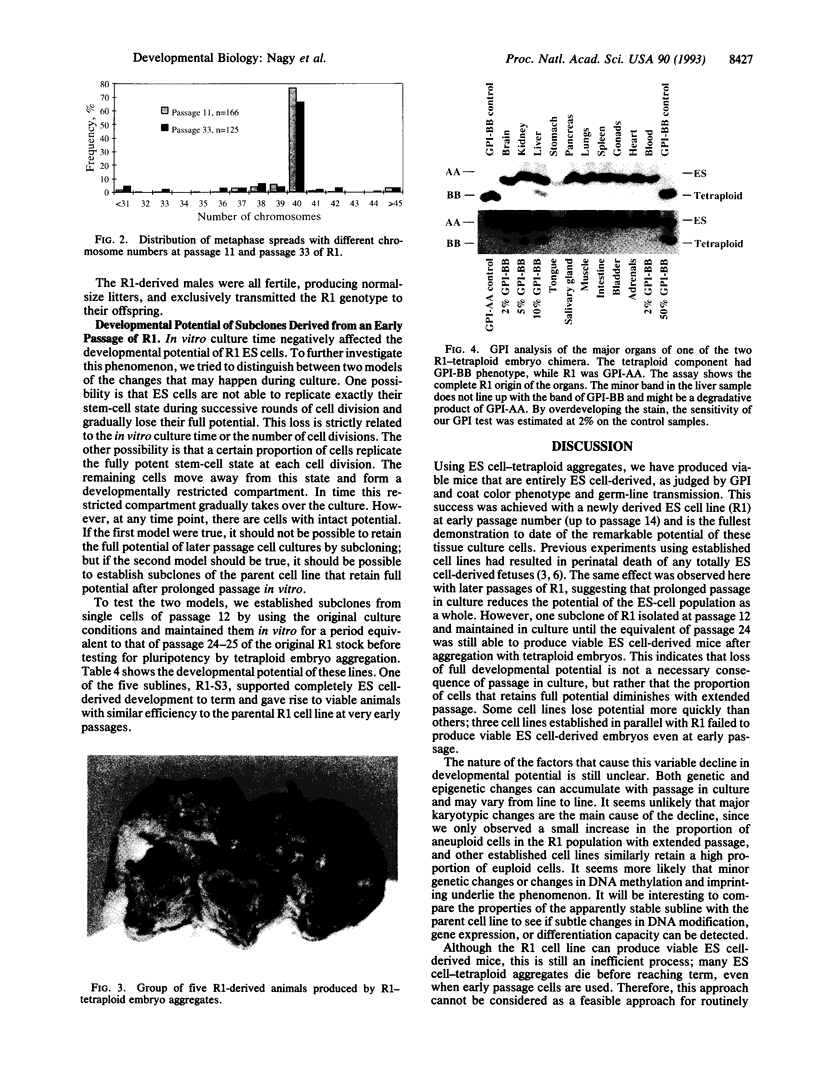Abstract
Several newly generated mouse embryonic stem (ES) cell lines were tested for their ability to produce completely ES cell-derived mice at early passage numbers by ES cell <==> tetraploid embryo aggregation. One line, designated R1, produced live offspring which were completely ES cell-derived as judged by isoenzyme analysis and coat color. These cell culture-derived animals were normal, viable, and fertile. However, prolonged in vitro culture negatively affected this initial totipotency of R1, and after passage 14, ES cell-derived newborns died at birth. However, one of the five subclones (R1-S3) derived from single cells at passage 12 retained the original totipotency and gave rise to viable, completely ES cell-derived animals. The total in vitro culture time of the sublines at the time of testing was equivalent to passage 24 of the original line. Fully potent early passage R1 cells and the R1-S3 subclone should be very useful not only for ES cell-based genetic manipulations but also in defining optimal in vitro culture conditions for retaining the initial totipotency of ES cells.
Full text
PDF




Images in this article
Selected References
These references are in PubMed. This may not be the complete list of references from this article.
- Bishop C. E., Boursot P., Baron B., Bonhomme F., Hatat D. Most classical Mus musculus domesticus laboratory mouse strains carry a Mus musculus musculus Y chromosome. Nature. 1985 May 2;315(6014):70–72. doi: 10.1038/315070a0. [DOI] [PubMed] [Google Scholar]
- Doetschman T. C., Eistetter H., Katz M., Schmidt W., Kemler R. The in vitro development of blastocyst-derived embryonic stem cell lines: formation of visceral yolk sac, blood islands and myocardium. J Embryol Exp Morphol. 1985 Jun;87:27–45. [PubMed] [Google Scholar]
- Evans M. J., Kaufman M. H. Establishment in culture of pluripotential cells from mouse embryos. Nature. 1981 Jul 9;292(5819):154–156. doi: 10.1038/292154a0. [DOI] [PubMed] [Google Scholar]
- Forrester L. M., Bernstein A., Rossant J., Nagy A. Long-term reconstitution of the mouse hematopoietic system by embryonic stem cell-derived fetal liver. Proc Natl Acad Sci U S A. 1991 Sep 1;88(17):7514–7517. doi: 10.1073/pnas.88.17.7514. [DOI] [PMC free article] [PubMed] [Google Scholar]
- Koller B. H., Smithies O. Altering genes in animals by gene targeting. Annu Rev Immunol. 1992;10:705–730. doi: 10.1146/annurev.iy.10.040192.003421. [DOI] [PubMed] [Google Scholar]
- Kubiak J. Z., Tarkowski A. K. Electrofusion of mouse blastomeres. Exp Cell Res. 1985 Apr;157(2):561–566. doi: 10.1016/0014-4827(85)90143-0. [DOI] [PubMed] [Google Scholar]
- McMahon A. P., Bradley A. The Wnt-1 (int-1) proto-oncogene is required for development of a large region of the mouse brain. Cell. 1990 Sep 21;62(6):1073–1085. doi: 10.1016/0092-8674(90)90385-r. [DOI] [PubMed] [Google Scholar]
- Nagy A., Gócza E., Diaz E. M., Prideaux V. R., Iványi E., Markkula M., Rossant J. Embryonic stem cells alone are able to support fetal development in the mouse. Development. 1990 Nov;110(3):815–821. doi: 10.1242/dev.110.3.815. [DOI] [PubMed] [Google Scholar]
- Quinn P., Barros C., Whittingham D. G. Preservation of hamster oocytes to assay the fertilizing capacity of human spermatozoa. J Reprod Fertil. 1982 Sep;66(1):161–168. doi: 10.1530/jrf.0.0660161. [DOI] [PubMed] [Google Scholar]
- Rossant J., Bernelot-Moens C., Nagy A. Genome manipulation in embryonic stem cells. Philos Trans R Soc Lond B Biol Sci. 1993 Feb 27;339(1288):207–215. doi: 10.1098/rstb.1993.0018. [DOI] [PubMed] [Google Scholar]






